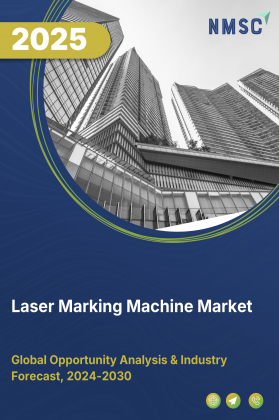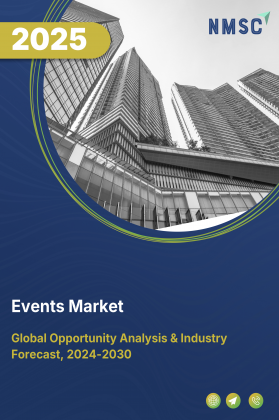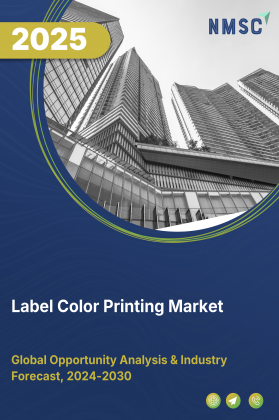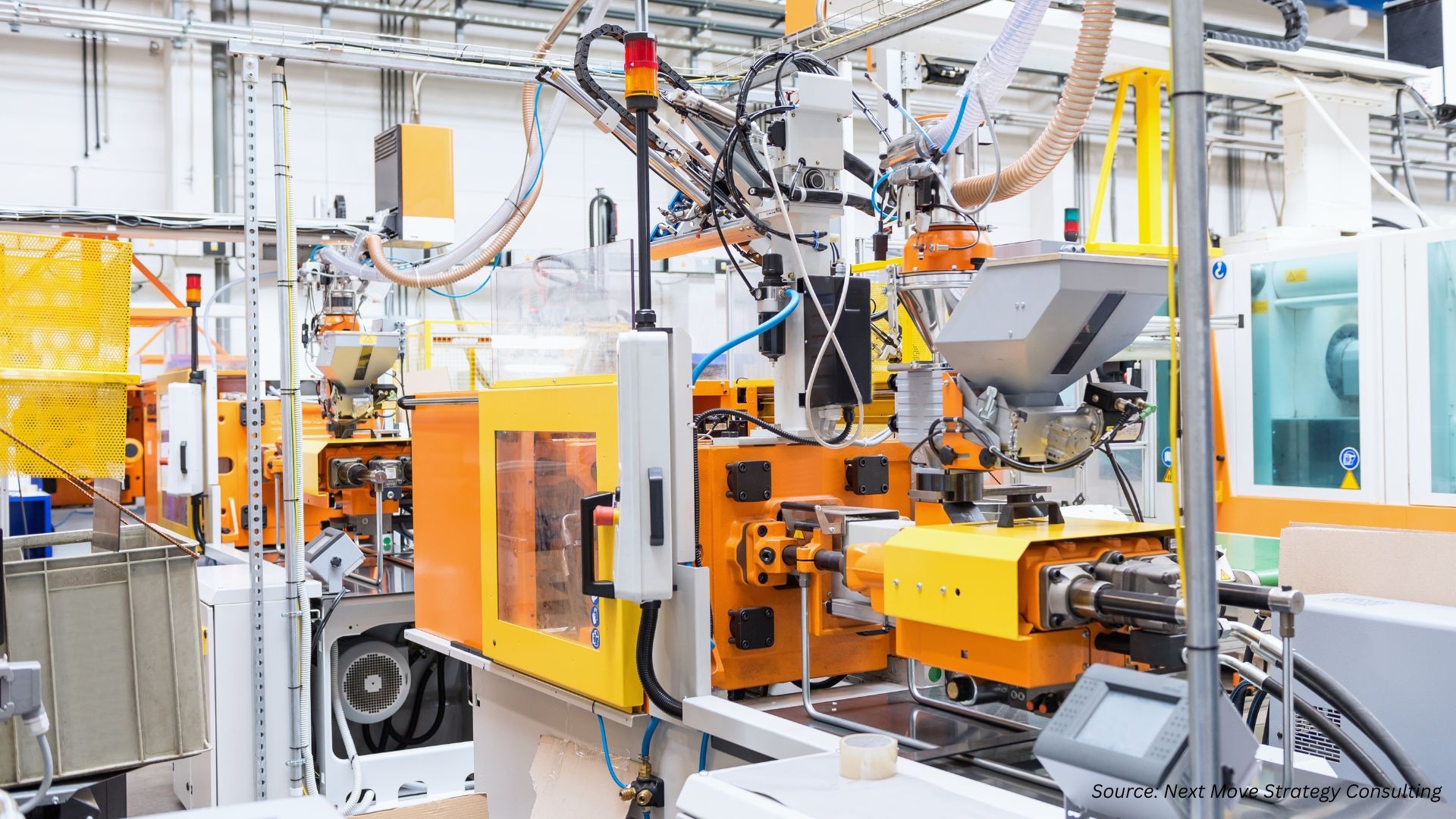
Laser Marking Machine Market by Material (Metal, Glass, Plastics and Others), by Product Type (Fiber Laser, Diode Laser, Solid-State Laser and Others), by Mobility Type (Inline, Fixed Workstations, Portable), by Marking Process (Engraving, Annealing and Others), and by End-Use Industry (Automotive, Electronics & Semiconductors, Healthcare, Aerospace & Defense and Others) – Global Opportunity Analysis and Industry Forecast, 2025–2030
Laser Marking Machine Industry Outlook
The global Laser Marking Machine Market size was valued at USD 4.16 billion in 2024, with an estimation of USD 4.58 billion in 2025 and is predicted to reach USD 7.48 billion by 2030 with a CAGR of 10.3% from 2025-2030. The sector is expanding rapidly, driven by growing demand across automotive, electronics, and packaging industries.
Automotive manufacturers rely on laser marking for precise, durable, and efficient identification of components, ensuring traceability, quality, and compliance without compromising part integrity. In electronics, the miniaturization of components and adoption of advanced technologies such as IoT, 5G, and electric vehicle electronics are increasing the need for high-speed, contactless, and damage-free marking on metals, plastics, and other delicate materials.
The packaging sector is also fueling growth, with laser marking providing accurate, eco-friendly solutions for barcodes, QR codes, batch numbers, and regulatory information, while supporting anti-counterfeiting measures and sustainable materials. Overall, the market is driven by industries prioritizing efficiency, traceability, and quality, with laser marking technologies offering versatile and high-performance solutions across diverse applications.
Rising Car Sales Accelerate Demand for Laser Marking Machines
The surge in global car sales, particularly electric vehicles, is fueling the demand for laser marking machines, as automotive manufacturers increasingly rely on precise, durable, and efficient marking solutions for components. Every vehicle comprises thousands of parts that require permanent identification for traceability, safety compliance, and quality assurance ranging from engine parts and chassis to electrical components.
According to the International Energy Agency, global electric car sales surpassed 17 million units in 2024, an increase of over 25% compared to the previous year. Notably, the additional 3.5 million electric cars sold in 2024 alone exceeded the total electric car sales recorded in 2020. This surge in production amplifies the need for high-speed, accurate, and cost-effective marking technologies like laser marking, especially as automakers adopt advanced materials and meet stringent regulatory standards without compromising part integrity.
Expanding Electronics Industry Fuels Laser Marking Machine Market Growth
The rapid expansion of the electronics industry is significantly shaping the laser marking machine market growth as manufacturers demand precise, high-speed, and permanent marking solutions for a wide range of electronic components. Modern electronics, including semiconductors, printed circuit boards, microchips, and consumer devices, require unique identification codes, logos, and compliance labels for traceability, quality assurance, and counterfeit prevention.
With the rising adoption of advanced technologies such as 5G, IoT devices, and electric vehicle electronics, the need for miniaturized components with intricate markings has grown exponentially. Laser marking machines provide the accuracy and efficiency needed for these delicate applications, offering contactless and damage-free marking on metals, plastics, and other materials used in electronics.
Moreover, as electronics manufacturing shifts toward automation and high-volume production, the integration of laser marking systems enables real-time coding, high throughput, and compliance with international quality standards, further boosting the laser marking machine market demand.
Booming Packaging Industry Drives Laser Marking Machine Demand
The packaging industry is emerging as a key driver for the laser marking machine market as manufacturers focus on product traceability, branding, and regulatory compliance. With rising demand for packaged food, beverages, pharmaceuticals, and consumer goods, companies increasingly require high-speed, accurate, and permanent marking solutions for barcodes, batch numbers, QR codes, and expiration dates on packaging materials.
Laser marking machines offer superior precision, non-contact marking, and eco-friendly operation compared to traditional ink-based methods, making them ideal for flexible packaging, labels, and cartons.
Additionally, the growing focus on anti-counterfeiting measures and the shift toward sustainable packaging materials are boosting the adoption of laser marking systems, as they mark complex surfaces without affecting recyclability or product integrity. As e-commerce and FMCG sectors witness rapid growth, the need for efficient and reliable product identification solutions continues to fuel the packaging industry’s demand for laser marking technologies.
High Initial Investment and Maintenance Costs Restrain the Market Growth
One of the key restraints in the laser marking machine market expansion is the high initial investment and associated maintenance costs. While laser marking offers long-term benefits such as precision, durability, and low operational expenses, the upfront cost of acquiring advanced systems be prohibitive for small and medium-sized enterprises.
Additionally, regular maintenance, operator training, and integration with existing production lines add to the overall expenses. These factors push smaller manufacturers to rely on conventional marking methods, slowing down the adoption rate of laser marking machines in cost-sensitive markets.
Rising Adoption of Industry 4.0 and Automation Creates Future Growth Opportunity
The growing adoption of Industry 4.0 and smart manufacturing presents a significant opportunity for the market. As manufacturers increasingly invest in automated production lines and digital traceability systems, the demand for marking solutions that offer real-time data integration, high-speed operation, and superior accuracy is surging.
Laser marking machines, when integrated with IoT and AI-based monitoring systems, enable seamless traceability, predictive maintenance, and compliance with stringent quality standards. Furthermore, the rise of electric vehicles, miniaturized electronics, and sustainable packaging solutions opens new avenues for laser marking technologies across diverse industries.
Market Segmentations and Scope of the Study
The laser marking machine market report is segmented on the basis of material, product type, mobility type, power class, marking process, sales channel, application, and end-use industry. On the basis of material, the market is divided into metal, glass, plastics, ceramics, and others. By product type, the market is classified into fiber laser, diode laser, solid-state laser, CO₂ laser, UV laser, green laser, and others. Based on mobility type, the market is segmented into inline, fixed workstations, and portable. By power class, the market is divided into ≤10 W, 11–20 W, and 21–50 W. On the basis of marking process, the market is categorized into engraving, annealing, ablation, foaming, and others. Based on distributional channel, the market is segmented into direct sales, third-party distributors, and online platforms. On the basis of application, the market is classified into product identification & traceability, branding & graphics, regulatory & compliance marks, anti-counterfeit & security, and others. Finally, based on end-use industry, the market is divided into automotive, electronics & semiconductors, healthcare, aerospace & defense, packaging & labeling, jewelry & personalization, energy, and others.
Geographical Analysis
In North America, the healthcare industry is a major driver of the laser marking machine market share due to the increasing production and complexity of medical devices, surgical instruments, implants, and pharmaceutical packaging. These products require permanent, legible, and precise markings such as UDI codes, lot numbers, and batch information to comply with strict FDA, ISO, and other regional regulatory standards.
As manufacturers scale up production and adopt automation, they increasingly rely on laser marking systems for clean, sterile, and abrasion-resistant marks on metals, plastics, and polymers. This not only reduces the need for consumables and rework but also ensures full traceability, quality assurance, and patient safety across the supply chain.
In Europe, the rapid adoption of Industry 4.0 and smart manufacturing technologies is a key factor driving the sector. Manufacturers across automotive, electronics, packaging, and industrial equipment sectors are increasingly integrating automated production lines, IoT-enabled monitoring, and AI-driven quality control systems.
Laser marking machines provide high-speed, precise, and durable markings that be linked to MES/ERP systems for real-time serialization, traceability, and predictive maintenance. Additionally, the region’s focus on sustainability and eco-friendly practices encourages the use of non-toxic, solvent-free laser marking solutions on diverse substrates, supporting both regulatory compliance and environmental goals.
In Asia Pacific, the booming automotive manufacturing sector is the primary driver of the laser marking machine market trends. Countries such as China, Japan, South Korea, and India are major hubs for the production of internal combustion vehicles, electric vehicles, and auto components, all of which require durable markings for VIN plates, powertrain components, battery modules, and electronic connectors.
According to IEA, In China, the number of new electric car registrations reached 8.1 million in 2023, increasing by 35% relative to 2022 further boosts the need for high-precision, high-speed laser marking systems that ensure traceability, compliance, and quality assurance across complex automotive parts.
The Rest of the World (RoW), including Latin America, the Middle East, and Africa, is witnessing steady growth in laser marking machine adoption due to expanding industrialization and increasing regulatory requirements for product labeling and traceability.
Automotive assembly plants, consumer electronics manufacturers, and pharmaceutical packaging companies in countries like Brazil, Mexico, the UAE, and South Africa are transitioning from traditional ink-based marking to laser solutions. This shift helps reduce counterfeiting risks, enhance mark durability, and improve overall production efficiency while aligning with international quality standards.
Strategic Innovations Adopted by Key Players
Key players in the laser marking machine industry are accelerating global expansion through upscale brand launches, service diversification, and strategic partnerships.
-
In June 2025, TRUMPF GmbH + Co. KG has announced a 50% increase in the maximum power of its TruMicro 6030 ultra-short pulse laser, a move expected to significantly enhance productivity in micro processing applications. The upgraded system offers faster, more precise laser marking capabilities for industrial components, electronics, and automotive parts. Analysts suggest this enhancement strengthens TRUMPF’s competitive position in the global market, meeting growing demand for high-speed, high-precision marking solutions across multiple industries.
-
In June 2025, IPG Photonics Corporation has unveiled its latest high-power lasers built on a new rack-integrated platform, designed to deliver cost savings, simplified integration, and enhanced operational reliability. The innovation is poised to benefit manufacturers using laser marking machines, offering faster, more precise, and energy-efficient marking for industrial components, electronics, and automotive parts. Industry experts note that this development reinforces IPG Photonics’ position in the global market, catering to increasing demand for high-performance, reliable marking solutions.
Key Benefits
-
The report provides quantitative analysis and estimations of the industry from 2025 to 2030, which assists in identifying the prevailing laser marking machine market opportunities.
-
The study comprises a deep-dive analysis of the current and future laser marking machine market trends to depict prevalent investment pockets in the sector.
-
Information related to key drivers, restraints, and opportunities and their impact on the market is provided in the report.
-
Competitive analysis of the players, along with their market share is provided in the report.
-
SWOT analysis and Porters Five Forces model is elaborated in the study.
-
Value chain analysis in the market study provides a clear picture of roles of stakeholders
Laser Marking Machine Market Key Segments
By Material
-
Metal
-
Glass
-
Plastics
-
Ceramics
-
Others
By Product Type
-
Fiber Laser
-
Diode Laser
-
Solid-State Laser
-
CO2 Laser
-
UV Laser
-
Green Laser
-
Others
By Mobility Type
-
Inline
-
Fixed Workstations
-
Portable
By Power Class
-
≤10 W
-
11–20 W
-
21–50 W
By Marking Process
-
Engraving
-
Annealing
-
Ablation
-
Foaming
-
Others
By Distribution Channel
-
Direct Sales
-
Third Party Distributor
-
E-commerce
By Application
-
Product Identification & Traceability
-
Branding & Graphics
-
Regulatory & Compliance Marks
-
Anti-counterfeit & Security
-
Others
By End Use Industry
-
Automotive
-
Electronics & Semiconductors
-
Healthcare
-
Aerospace & Defense
-
Packaging & Labeling
-
Jewelry & Personalization
-
Energy
-
Others
By Region
-
North America
-
The U.S.
-
Canada
-
Mexico
-
-
Europe
-
The UK
-
Germany
-
France
-
Italy
-
Spain
-
Denmark
-
Netherlands
-
Finland
-
Sweden
-
Norway
-
Russia
-
Rest of Europe
-
-
Asia-Pacific
-
China
-
Japan
-
India
-
South Korea
-
Australia
-
Indonesia
-
Singapore
-
Taiwan
-
Thailand
-
Rest of Asia-Pacific
-
-
RoW
-
Latin America
-
Middle East
-
Africa
-
Key Players
-
IPG Photonics Corporation
-
Keyence Corporation
-
Han’s Laser Technology Industry Group Co., Ltd.
-
Gravotech Group
-
Trotec Laser GmbH
-
Epilog Laser
-
Mecco Partners LLC
-
Videojet Technologies, Inc.
-
LaserStar Technologies Corporation
-
Telesis Technologies, Inc.
-
SIC Marking
-
Bodor Laser Co., Ltd.
-
Perfect Laser Co. Ltd.
Report Scope and Segmentation:
|
Parameters |
Details |
|
Market Size in 2025 |
USD 4.58 Billion |
|
Revenue Forecast in 2030 |
USD 7.48 Billion |
|
Growth Rate |
CAGR of 10.3% from 2025 to 2030 |
|
Analysis Period |
2024–2030 |
|
Base Year Considered |
2024 |
|
Forecast Period |
2025–2030 |
|
Market Size Estimation |
Million (USD) |
|
Growth Factors |
|
|
Countries Covered |
28 |
|
Companies Profiled |
15 |
|
Market Share |
Available for 10 companies |
|
Customization Scope |
Free customization (equivalent up to 80 working hours of analysts) after purchase. Addition or alteration to country, regional, and segment scope. |
|
Pricing and Purchase Options |
Avail customized purchase options to meet your exact research needs. |
















 Speak to Our Analyst
Speak to Our Analyst
























